Barclays' Strategy: Tapping into New and International Markets Report
VerifiedAdded on 2023/01/16
|10
|2840
|70
Report
AI Summary
This report analyzes the global business environment, focusing on opportunities and threats for small and medium-sized enterprises (SMEs) in international markets, specifically from the perspective of Barclays, a financial institution. It explores the benefits of global trading blocs and agreements, such as the CARIFORUM-UK and SACUM-UK economic partnership agreements, and examines tariff and non-tariff barriers that impact international trade. The report highlights the impact of Brexit on the UK's global business environment, including changes in tax rates and monetary value, and discusses how SMEs can leverage opportunities like e-commerce to expand their market share. It also addresses challenges such as financial constraints and competition from larger organizations. The report details the advantages of free trade agreements for SMEs, including reduced taxation and increased profitability, and provides an overview of various tariff and non-tariff barriers, such as import duties and licensing requirements, that influence international trade. The report aims to provide a comprehensive overview of the global business environment and its implications for SMEs seeking to tap into new and international markets.
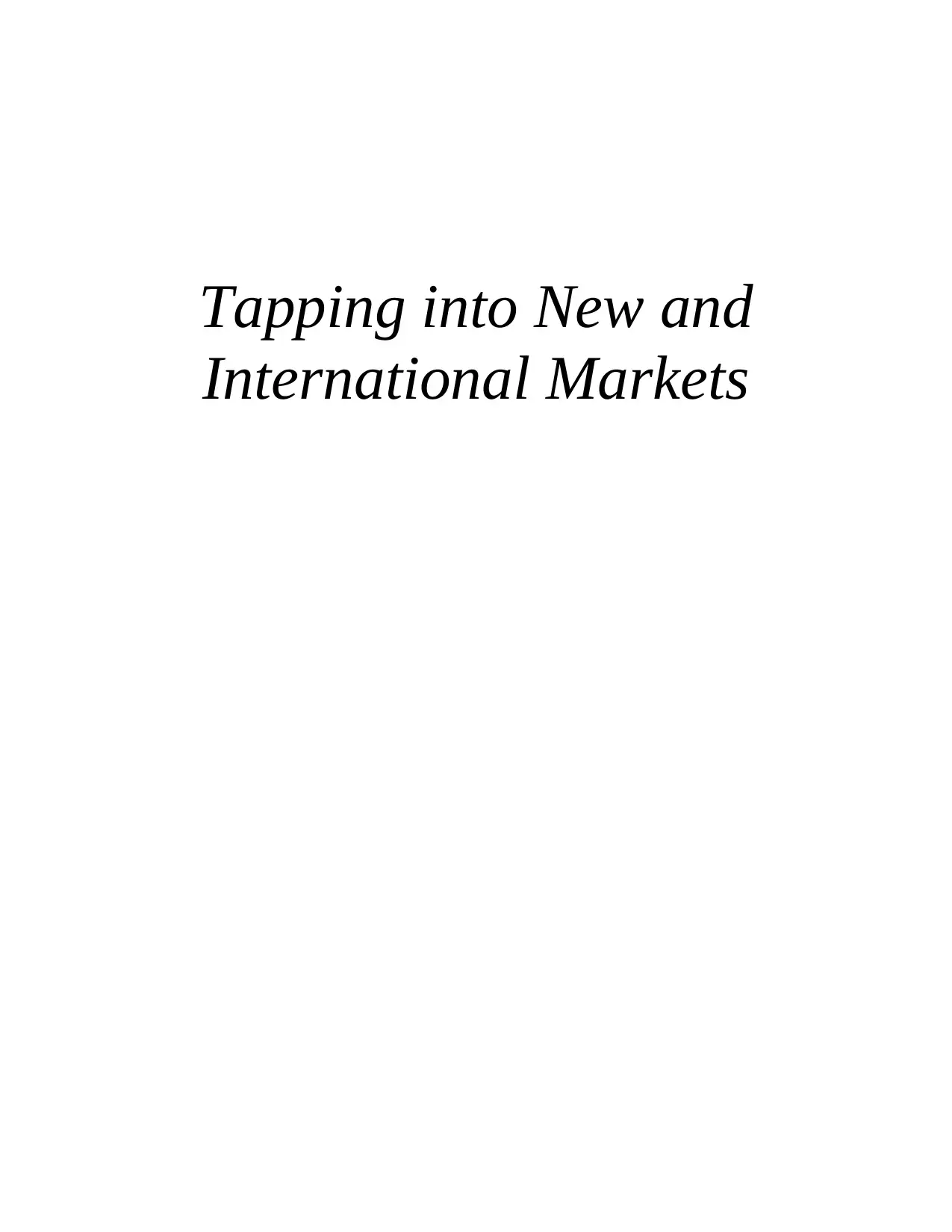
Tapping into New and
International Markets
International Markets
Paraphrase This Document
Need a fresh take? Get an instant paraphrase of this document with our AI Paraphraser
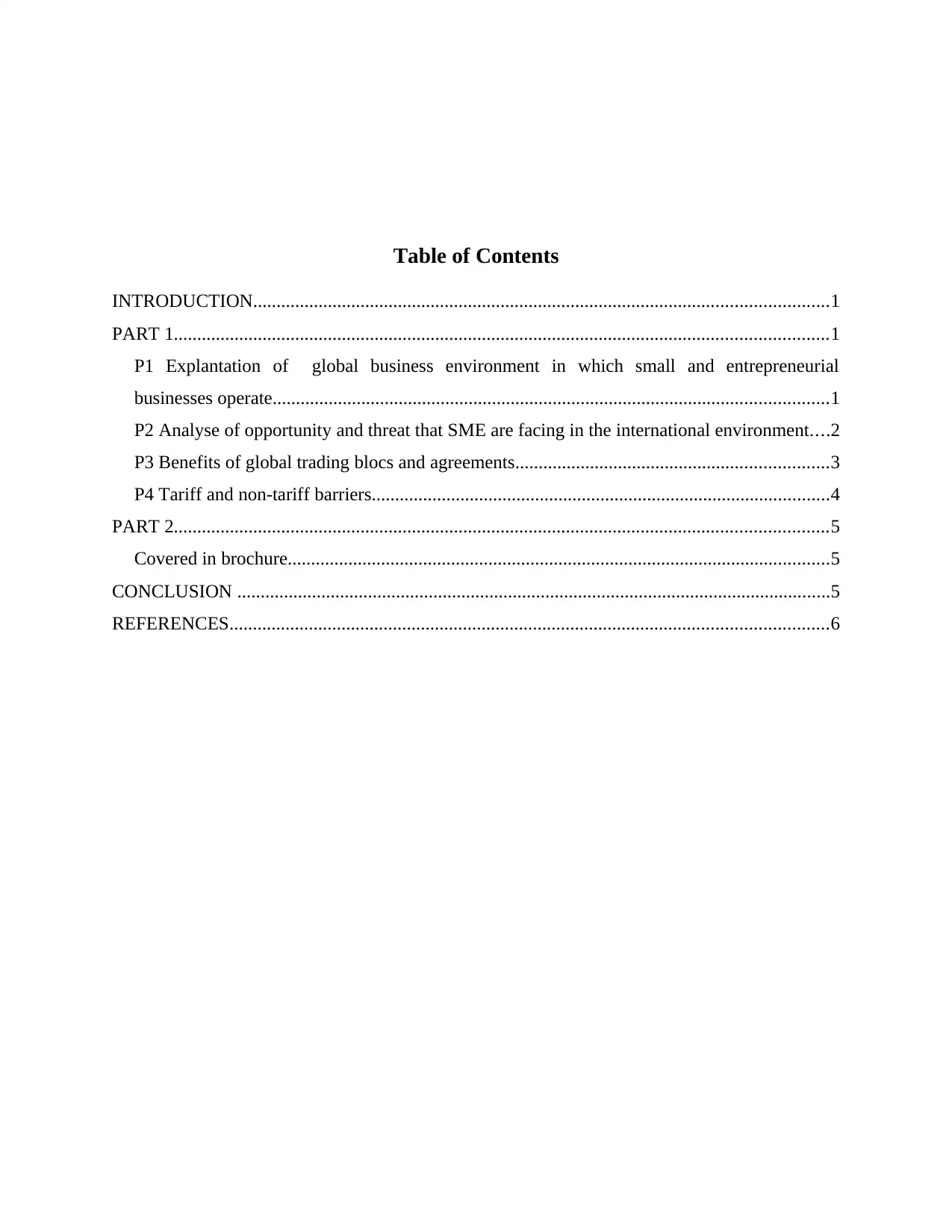
Table of Contents
INTRODUCTION...........................................................................................................................1
PART 1............................................................................................................................................1
P1 Explantation of global business environment in which small and entrepreneurial
businesses operate.......................................................................................................................1
P2 Analyse of opportunity and threat that SME are facing in the international environment....2
P3 Benefits of global trading blocs and agreements...................................................................3
P4 Tariff and non-tariff barriers..................................................................................................4
PART 2............................................................................................................................................5
Covered in brochure....................................................................................................................5
CONCLUSION ...............................................................................................................................5
REFERENCES................................................................................................................................6
INTRODUCTION...........................................................................................................................1
PART 1............................................................................................................................................1
P1 Explantation of global business environment in which small and entrepreneurial
businesses operate.......................................................................................................................1
P2 Analyse of opportunity and threat that SME are facing in the international environment....2
P3 Benefits of global trading blocs and agreements...................................................................3
P4 Tariff and non-tariff barriers..................................................................................................4
PART 2............................................................................................................................................5
Covered in brochure....................................................................................................................5
CONCLUSION ...............................................................................................................................5
REFERENCES................................................................................................................................6
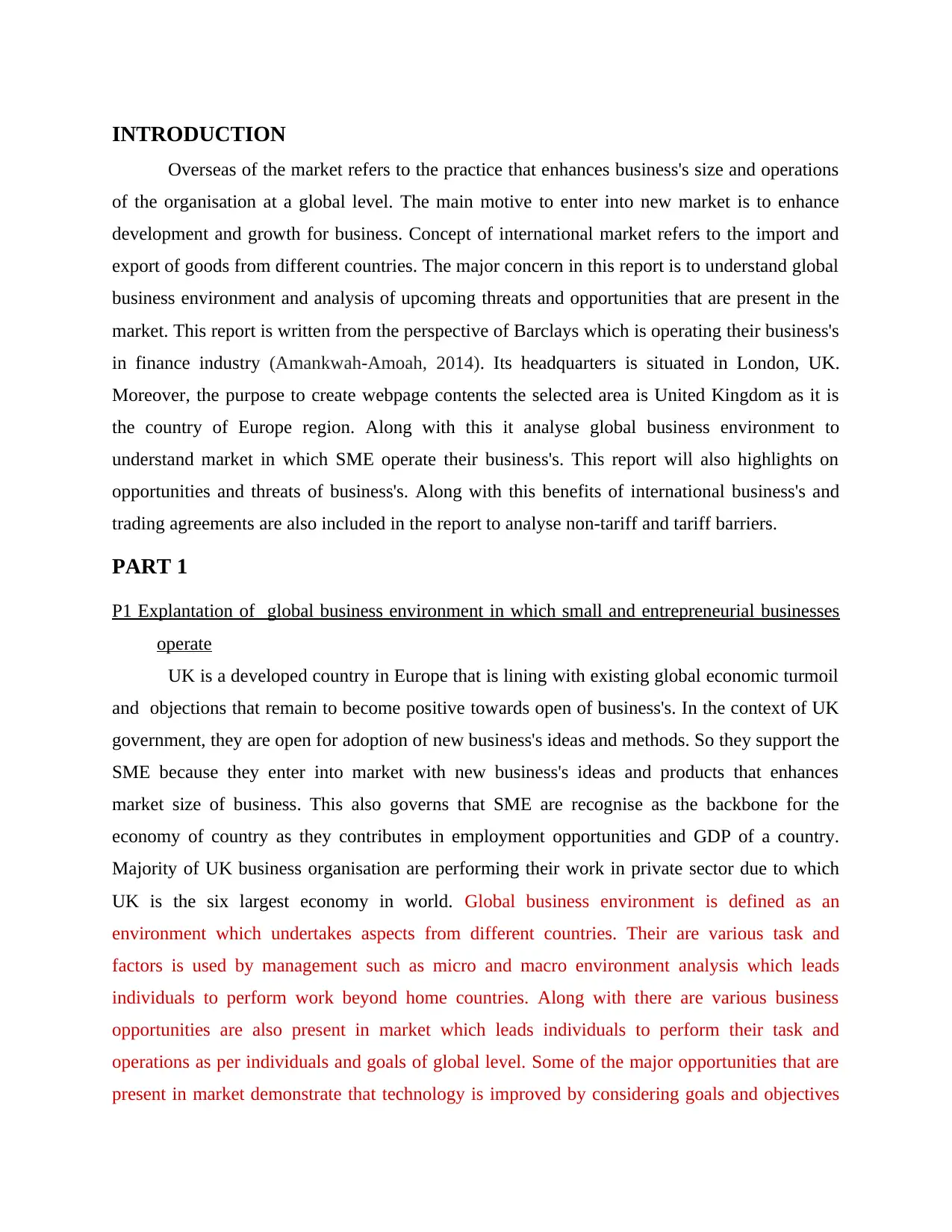
INTRODUCTION
Overseas of the market refers to the practice that enhances business's size and operations
of the organisation at a global level. The main motive to enter into new market is to enhance
development and growth for business. Concept of international market refers to the import and
export of goods from different countries. The major concern in this report is to understand global
business environment and analysis of upcoming threats and opportunities that are present in the
market. This report is written from the perspective of Barclays which is operating their business's
in finance industry (Amankwah‐Amoah, 2014). Its headquarters is situated in London, UK.
Moreover, the purpose to create webpage contents the selected area is United Kingdom as it is
the country of Europe region. Along with this it analyse global business environment to
understand market in which SME operate their business's. This report will also highlights on
opportunities and threats of business's. Along with this benefits of international business's and
trading agreements are also included in the report to analyse non-tariff and tariff barriers.
PART 1
P1 Explantation of global business environment in which small and entrepreneurial businesses
operate
UK is a developed country in Europe that is lining with existing global economic turmoil
and objections that remain to become positive towards open of business's. In the context of UK
government, they are open for adoption of new business's ideas and methods. So they support the
SME because they enter into market with new business's ideas and products that enhances
market size of business. This also governs that SME are recognise as the backbone for the
economy of country as they contributes in employment opportunities and GDP of a country.
Majority of UK business organisation are performing their work in private sector due to which
UK is the six largest economy in world. Global business environment is defined as an
environment which undertakes aspects from different countries. Their are various task and
factors is used by management such as micro and macro environment analysis which leads
individuals to perform work beyond home countries. Along with there are various business
opportunities are also present in market which leads individuals to perform their task and
operations as per individuals and goals of global level. Some of the major opportunities that are
present in market demonstrate that technology is improved by considering goals and objectives
Overseas of the market refers to the practice that enhances business's size and operations
of the organisation at a global level. The main motive to enter into new market is to enhance
development and growth for business. Concept of international market refers to the import and
export of goods from different countries. The major concern in this report is to understand global
business environment and analysis of upcoming threats and opportunities that are present in the
market. This report is written from the perspective of Barclays which is operating their business's
in finance industry (Amankwah‐Amoah, 2014). Its headquarters is situated in London, UK.
Moreover, the purpose to create webpage contents the selected area is United Kingdom as it is
the country of Europe region. Along with this it analyse global business environment to
understand market in which SME operate their business's. This report will also highlights on
opportunities and threats of business's. Along with this benefits of international business's and
trading agreements are also included in the report to analyse non-tariff and tariff barriers.
PART 1
P1 Explantation of global business environment in which small and entrepreneurial businesses
operate
UK is a developed country in Europe that is lining with existing global economic turmoil
and objections that remain to become positive towards open of business's. In the context of UK
government, they are open for adoption of new business's ideas and methods. So they support the
SME because they enter into market with new business's ideas and products that enhances
market size of business. This also governs that SME are recognise as the backbone for the
economy of country as they contributes in employment opportunities and GDP of a country.
Majority of UK business organisation are performing their work in private sector due to which
UK is the six largest economy in world. Global business environment is defined as an
environment which undertakes aspects from different countries. Their are various task and
factors is used by management such as micro and macro environment analysis which leads
individuals to perform work beyond home countries. Along with there are various business
opportunities are also present in market which leads individuals to perform their task and
operations as per individuals and goals of global level. Some of the major opportunities that are
present in market demonstrate that technology is improved by considering goals and objectives
⊘ This is a preview!⊘
Do you want full access?
Subscribe today to unlock all pages.

Trusted by 1+ million students worldwide
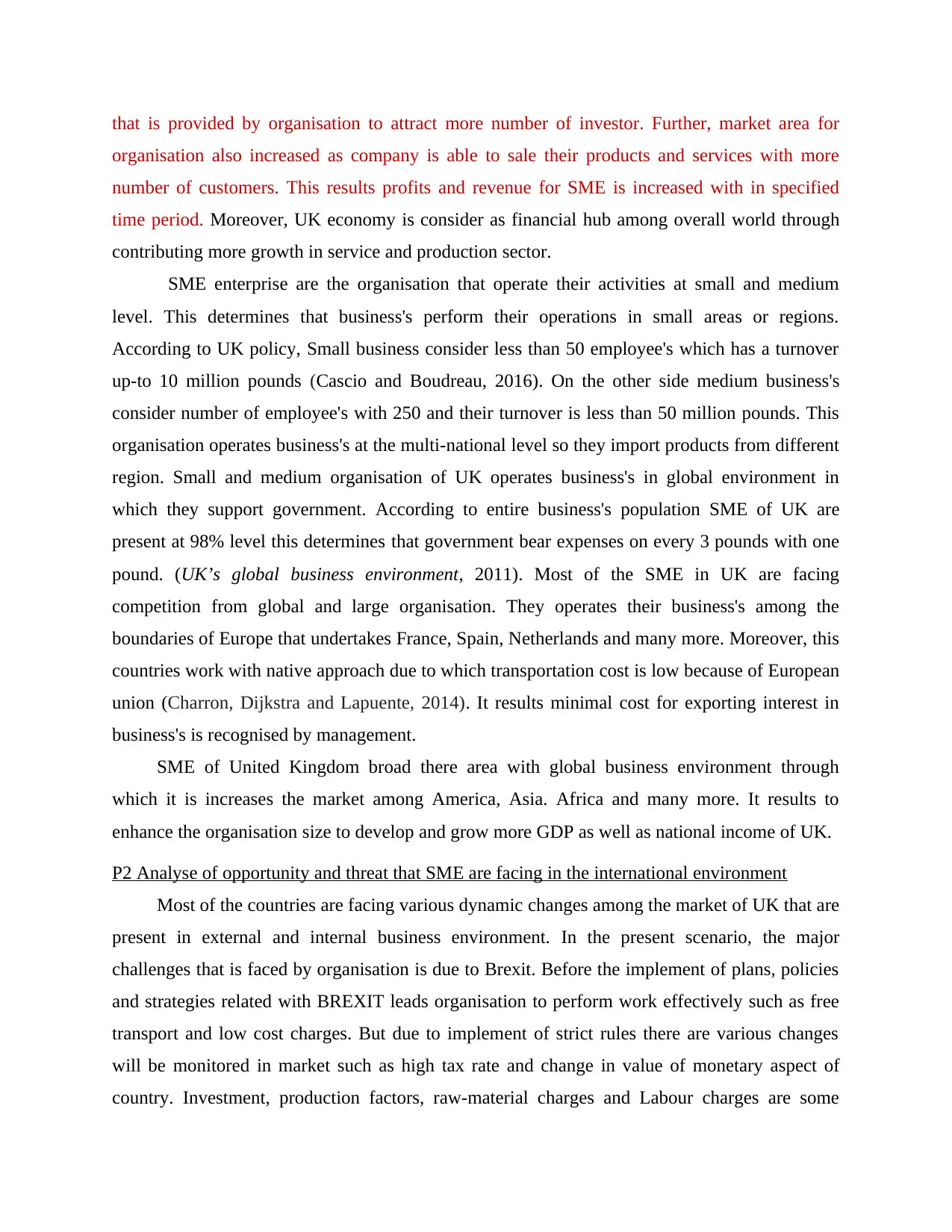
that is provided by organisation to attract more number of investor. Further, market area for
organisation also increased as company is able to sale their products and services with more
number of customers. This results profits and revenue for SME is increased with in specified
time period. Moreover, UK economy is consider as financial hub among overall world through
contributing more growth in service and production sector.
SME enterprise are the organisation that operate their activities at small and medium
level. This determines that business's perform their operations in small areas or regions.
According to UK policy, Small business consider less than 50 employee's which has a turnover
up-to 10 million pounds (Cascio and Boudreau, 2016). On the other side medium business's
consider number of employee's with 250 and their turnover is less than 50 million pounds. This
organisation operates business's at the multi-national level so they import products from different
region. Small and medium organisation of UK operates business's in global environment in
which they support government. According to entire business's population SME of UK are
present at 98% level this determines that government bear expenses on every 3 pounds with one
pound. (UK’s global business environment, 2011). Most of the SME in UK are facing
competition from global and large organisation. They operates their business's among the
boundaries of Europe that undertakes France, Spain, Netherlands and many more. Moreover, this
countries work with native approach due to which transportation cost is low because of European
union (Charron, Dijkstra and Lapuente, 2014). It results minimal cost for exporting interest in
business's is recognised by management.
SME of United Kingdom broad there area with global business environment through
which it is increases the market among America, Asia. Africa and many more. It results to
enhance the organisation size to develop and grow more GDP as well as national income of UK.
P2 Analyse of opportunity and threat that SME are facing in the international environment
Most of the countries are facing various dynamic changes among the market of UK that are
present in external and internal business environment. In the present scenario, the major
challenges that is faced by organisation is due to Brexit. Before the implement of plans, policies
and strategies related with BREXIT leads organisation to perform work effectively such as free
transport and low cost charges. But due to implement of strict rules there are various changes
will be monitored in market such as high tax rate and change in value of monetary aspect of
country. Investment, production factors, raw-material charges and Labour charges are some
organisation also increased as company is able to sale their products and services with more
number of customers. This results profits and revenue for SME is increased with in specified
time period. Moreover, UK economy is consider as financial hub among overall world through
contributing more growth in service and production sector.
SME enterprise are the organisation that operate their activities at small and medium
level. This determines that business's perform their operations in small areas or regions.
According to UK policy, Small business consider less than 50 employee's which has a turnover
up-to 10 million pounds (Cascio and Boudreau, 2016). On the other side medium business's
consider number of employee's with 250 and their turnover is less than 50 million pounds. This
organisation operates business's at the multi-national level so they import products from different
region. Small and medium organisation of UK operates business's in global environment in
which they support government. According to entire business's population SME of UK are
present at 98% level this determines that government bear expenses on every 3 pounds with one
pound. (UK’s global business environment, 2011). Most of the SME in UK are facing
competition from global and large organisation. They operates their business's among the
boundaries of Europe that undertakes France, Spain, Netherlands and many more. Moreover, this
countries work with native approach due to which transportation cost is low because of European
union (Charron, Dijkstra and Lapuente, 2014). It results minimal cost for exporting interest in
business's is recognised by management.
SME of United Kingdom broad there area with global business environment through
which it is increases the market among America, Asia. Africa and many more. It results to
enhance the organisation size to develop and grow more GDP as well as national income of UK.
P2 Analyse of opportunity and threat that SME are facing in the international environment
Most of the countries are facing various dynamic changes among the market of UK that are
present in external and internal business environment. In the present scenario, the major
challenges that is faced by organisation is due to Brexit. Before the implement of plans, policies
and strategies related with BREXIT leads organisation to perform work effectively such as free
transport and low cost charges. But due to implement of strict rules there are various changes
will be monitored in market such as high tax rate and change in value of monetary aspect of
country. Investment, production factors, raw-material charges and Labour charges are some
Paraphrase This Document
Need a fresh take? Get an instant paraphrase of this document with our AI Paraphraser
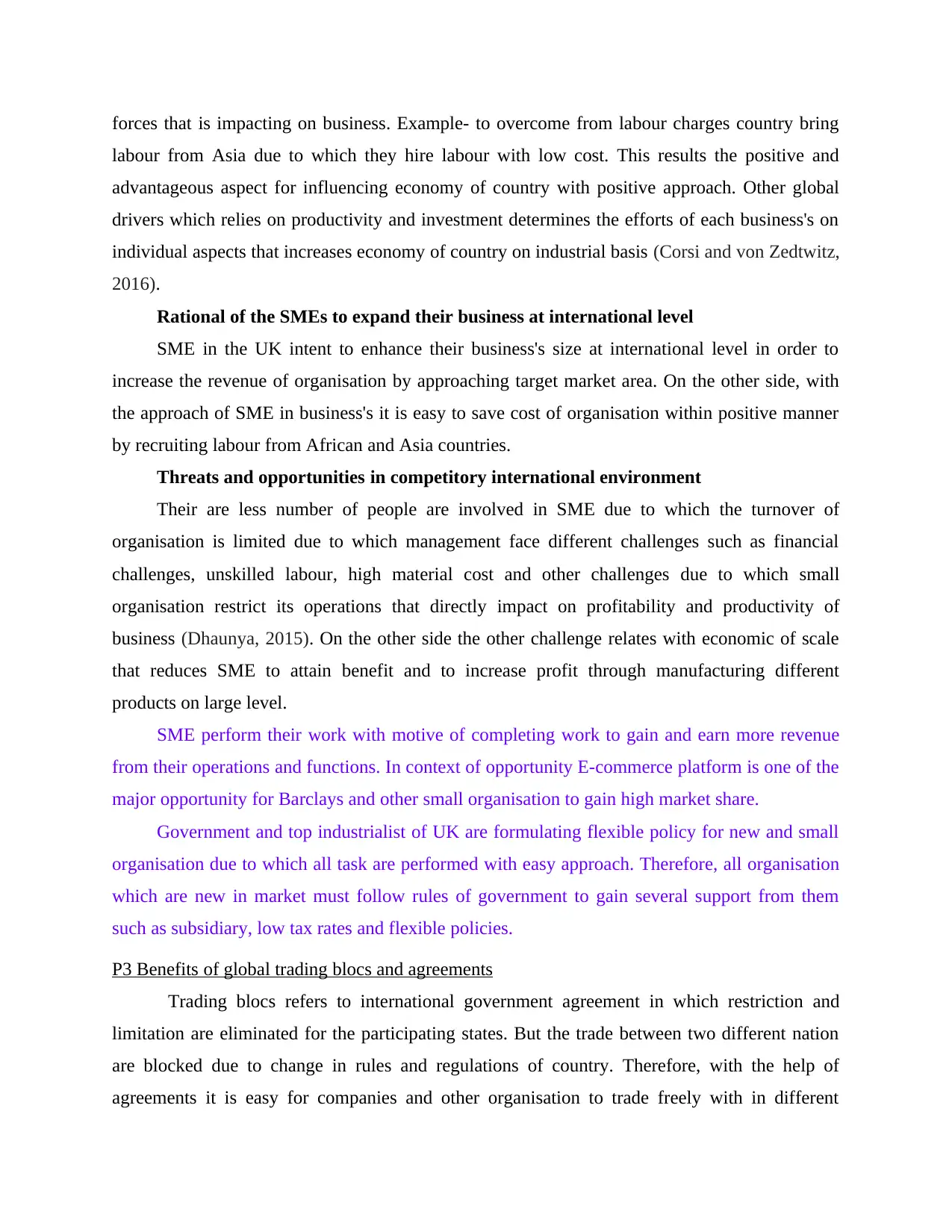
forces that is impacting on business. Example- to overcome from labour charges country bring
labour from Asia due to which they hire labour with low cost. This results the positive and
advantageous aspect for influencing economy of country with positive approach. Other global
drivers which relies on productivity and investment determines the efforts of each business's on
individual aspects that increases economy of country on industrial basis (Corsi and von Zedtwitz,
2016).
Rational of the SMEs to expand their business at international level
SME in the UK intent to enhance their business's size at international level in order to
increase the revenue of organisation by approaching target market area. On the other side, with
the approach of SME in business's it is easy to save cost of organisation within positive manner
by recruiting labour from African and Asia countries.
Threats and opportunities in competitory international environment
Their are less number of people are involved in SME due to which the turnover of
organisation is limited due to which management face different challenges such as financial
challenges, unskilled labour, high material cost and other challenges due to which small
organisation restrict its operations that directly impact on profitability and productivity of
business (Dhaunya, 2015). On the other side the other challenge relates with economic of scale
that reduces SME to attain benefit and to increase profit through manufacturing different
products on large level.
SME perform their work with motive of completing work to gain and earn more revenue
from their operations and functions. In context of opportunity E-commerce platform is one of the
major opportunity for Barclays and other small organisation to gain high market share.
Government and top industrialist of UK are formulating flexible policy for new and small
organisation due to which all task are performed with easy approach. Therefore, all organisation
which are new in market must follow rules of government to gain several support from them
such as subsidiary, low tax rates and flexible policies.
P3 Benefits of global trading blocs and agreements
Trading blocs refers to international government agreement in which restriction and
limitation are eliminated for the participating states. But the trade between two different nation
are blocked due to change in rules and regulations of country. Therefore, with the help of
agreements it is easy for companies and other organisation to trade freely with in different
labour from Asia due to which they hire labour with low cost. This results the positive and
advantageous aspect for influencing economy of country with positive approach. Other global
drivers which relies on productivity and investment determines the efforts of each business's on
individual aspects that increases economy of country on industrial basis (Corsi and von Zedtwitz,
2016).
Rational of the SMEs to expand their business at international level
SME in the UK intent to enhance their business's size at international level in order to
increase the revenue of organisation by approaching target market area. On the other side, with
the approach of SME in business's it is easy to save cost of organisation within positive manner
by recruiting labour from African and Asia countries.
Threats and opportunities in competitory international environment
Their are less number of people are involved in SME due to which the turnover of
organisation is limited due to which management face different challenges such as financial
challenges, unskilled labour, high material cost and other challenges due to which small
organisation restrict its operations that directly impact on profitability and productivity of
business (Dhaunya, 2015). On the other side the other challenge relates with economic of scale
that reduces SME to attain benefit and to increase profit through manufacturing different
products on large level.
SME perform their work with motive of completing work to gain and earn more revenue
from their operations and functions. In context of opportunity E-commerce platform is one of the
major opportunity for Barclays and other small organisation to gain high market share.
Government and top industrialist of UK are formulating flexible policy for new and small
organisation due to which all task are performed with easy approach. Therefore, all organisation
which are new in market must follow rules of government to gain several support from them
such as subsidiary, low tax rates and flexible policies.
P3 Benefits of global trading blocs and agreements
Trading blocs refers to international government agreement in which restriction and
limitation are eliminated for the participating states. But the trade between two different nation
are blocked due to change in rules and regulations of country. Therefore, with the help of
agreements it is easy for companies and other organisation to trade freely with in different
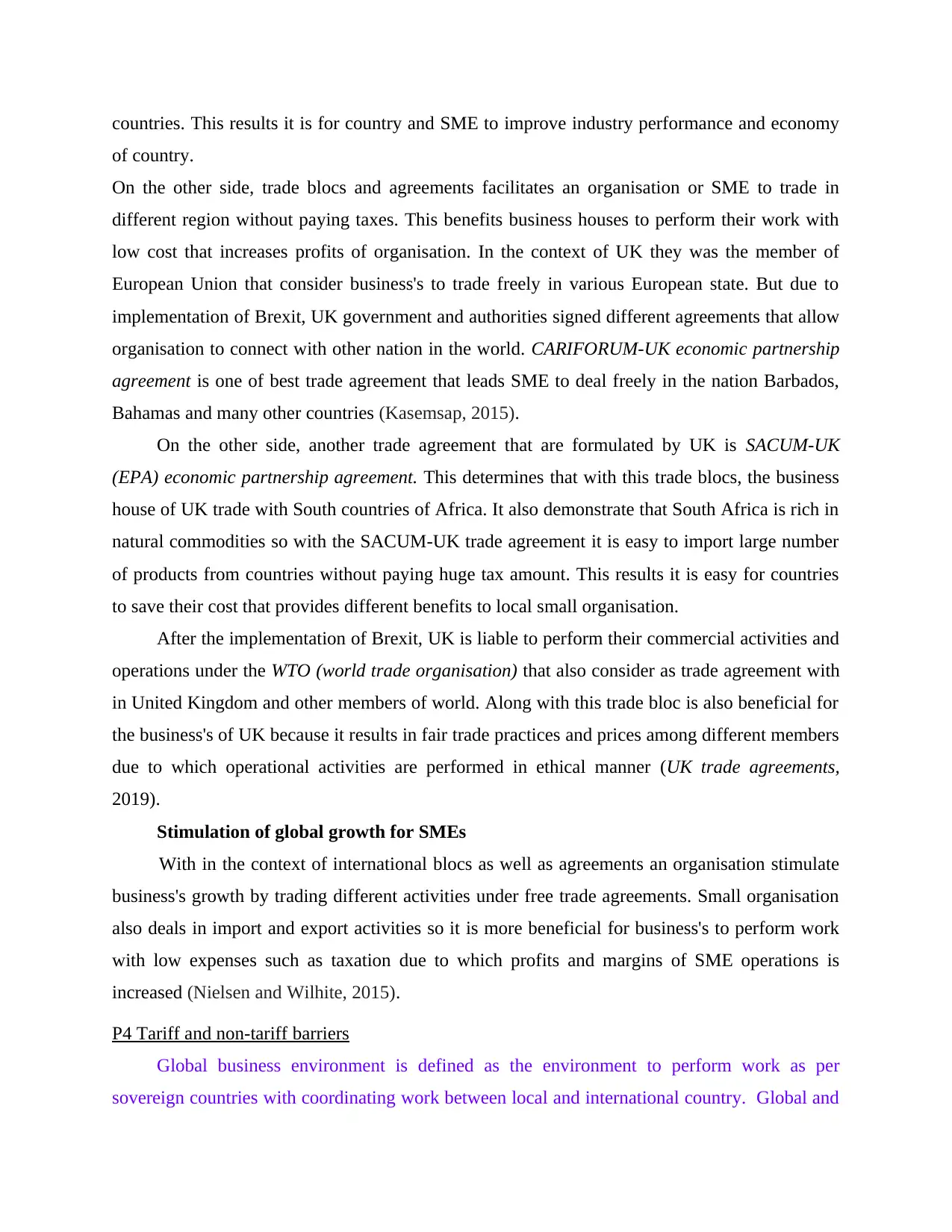
countries. This results it is for country and SME to improve industry performance and economy
of country.
On the other side, trade blocs and agreements facilitates an organisation or SME to trade in
different region without paying taxes. This benefits business houses to perform their work with
low cost that increases profits of organisation. In the context of UK they was the member of
European Union that consider business's to trade freely in various European state. But due to
implementation of Brexit, UK government and authorities signed different agreements that allow
organisation to connect with other nation in the world. CARIFORUM-UK economic partnership
agreement is one of best trade agreement that leads SME to deal freely in the nation Barbados,
Bahamas and many other countries (Kasemsap, 2015).
On the other side, another trade agreement that are formulated by UK is SACUM-UK
(EPA) economic partnership agreement. This determines that with this trade blocs, the business
house of UK trade with South countries of Africa. It also demonstrate that South Africa is rich in
natural commodities so with the SACUM-UK trade agreement it is easy to import large number
of products from countries without paying huge tax amount. This results it is easy for countries
to save their cost that provides different benefits to local small organisation.
After the implementation of Brexit, UK is liable to perform their commercial activities and
operations under the WTO (world trade organisation) that also consider as trade agreement with
in United Kingdom and other members of world. Along with this trade bloc is also beneficial for
the business's of UK because it results in fair trade practices and prices among different members
due to which operational activities are performed in ethical manner (UK trade agreements,
2019).
Stimulation of global growth for SMEs
With in the context of international blocs as well as agreements an organisation stimulate
business's growth by trading different activities under free trade agreements. Small organisation
also deals in import and export activities so it is more beneficial for business's to perform work
with low expenses such as taxation due to which profits and margins of SME operations is
increased (Nielsen and Wilhite, 2015).
P4 Tariff and non-tariff barriers
Global business environment is defined as the environment to perform work as per
sovereign countries with coordinating work between local and international country. Global and
of country.
On the other side, trade blocs and agreements facilitates an organisation or SME to trade in
different region without paying taxes. This benefits business houses to perform their work with
low cost that increases profits of organisation. In the context of UK they was the member of
European Union that consider business's to trade freely in various European state. But due to
implementation of Brexit, UK government and authorities signed different agreements that allow
organisation to connect with other nation in the world. CARIFORUM-UK economic partnership
agreement is one of best trade agreement that leads SME to deal freely in the nation Barbados,
Bahamas and many other countries (Kasemsap, 2015).
On the other side, another trade agreement that are formulated by UK is SACUM-UK
(EPA) economic partnership agreement. This determines that with this trade blocs, the business
house of UK trade with South countries of Africa. It also demonstrate that South Africa is rich in
natural commodities so with the SACUM-UK trade agreement it is easy to import large number
of products from countries without paying huge tax amount. This results it is easy for countries
to save their cost that provides different benefits to local small organisation.
After the implementation of Brexit, UK is liable to perform their commercial activities and
operations under the WTO (world trade organisation) that also consider as trade agreement with
in United Kingdom and other members of world. Along with this trade bloc is also beneficial for
the business's of UK because it results in fair trade practices and prices among different members
due to which operational activities are performed in ethical manner (UK trade agreements,
2019).
Stimulation of global growth for SMEs
With in the context of international blocs as well as agreements an organisation stimulate
business's growth by trading different activities under free trade agreements. Small organisation
also deals in import and export activities so it is more beneficial for business's to perform work
with low expenses such as taxation due to which profits and margins of SME operations is
increased (Nielsen and Wilhite, 2015).
P4 Tariff and non-tariff barriers
Global business environment is defined as the environment to perform work as per
sovereign countries with coordinating work between local and international country. Global and
⊘ This is a preview!⊘
Do you want full access?
Subscribe today to unlock all pages.

Trusted by 1+ million students worldwide
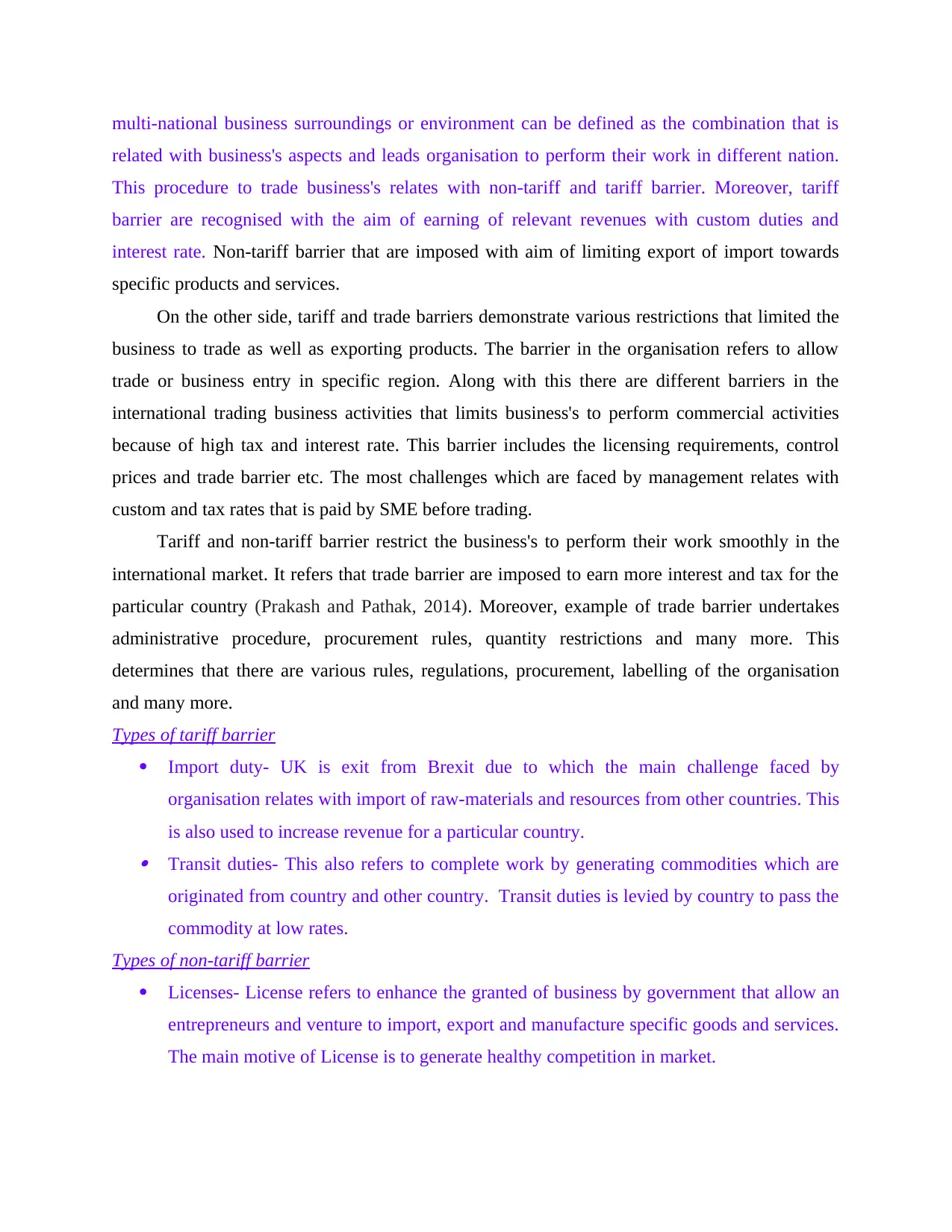
multi-national business surroundings or environment can be defined as the combination that is
related with business's aspects and leads organisation to perform their work in different nation.
This procedure to trade business's relates with non-tariff and tariff barrier. Moreover, tariff
barrier are recognised with the aim of earning of relevant revenues with custom duties and
interest rate. Non-tariff barrier that are imposed with aim of limiting export of import towards
specific products and services.
On the other side, tariff and trade barriers demonstrate various restrictions that limited the
business to trade as well as exporting products. The barrier in the organisation refers to allow
trade or business entry in specific region. Along with this there are different barriers in the
international trading business activities that limits business's to perform commercial activities
because of high tax and interest rate. This barrier includes the licensing requirements, control
prices and trade barrier etc. The most challenges which are faced by management relates with
custom and tax rates that is paid by SME before trading.
Tariff and non-tariff barrier restrict the business's to perform their work smoothly in the
international market. It refers that trade barrier are imposed to earn more interest and tax for the
particular country (Prakash and Pathak, 2014). Moreover, example of trade barrier undertakes
administrative procedure, procurement rules, quantity restrictions and many more. This
determines that there are various rules, regulations, procurement, labelling of the organisation
and many more.
Types of tariff barrier
Import duty- UK is exit from Brexit due to which the main challenge faced by
organisation relates with import of raw-materials and resources from other countries. This
is also used to increase revenue for a particular country. Transit duties- This also refers to complete work by generating commodities which are
originated from country and other country. Transit duties is levied by country to pass the
commodity at low rates.
Types of non-tariff barrier
Licenses- License refers to enhance the granted of business by government that allow an
entrepreneurs and venture to import, export and manufacture specific goods and services.
The main motive of License is to generate healthy competition in market.
related with business's aspects and leads organisation to perform their work in different nation.
This procedure to trade business's relates with non-tariff and tariff barrier. Moreover, tariff
barrier are recognised with the aim of earning of relevant revenues with custom duties and
interest rate. Non-tariff barrier that are imposed with aim of limiting export of import towards
specific products and services.
On the other side, tariff and trade barriers demonstrate various restrictions that limited the
business to trade as well as exporting products. The barrier in the organisation refers to allow
trade or business entry in specific region. Along with this there are different barriers in the
international trading business activities that limits business's to perform commercial activities
because of high tax and interest rate. This barrier includes the licensing requirements, control
prices and trade barrier etc. The most challenges which are faced by management relates with
custom and tax rates that is paid by SME before trading.
Tariff and non-tariff barrier restrict the business's to perform their work smoothly in the
international market. It refers that trade barrier are imposed to earn more interest and tax for the
particular country (Prakash and Pathak, 2014). Moreover, example of trade barrier undertakes
administrative procedure, procurement rules, quantity restrictions and many more. This
determines that there are various rules, regulations, procurement, labelling of the organisation
and many more.
Types of tariff barrier
Import duty- UK is exit from Brexit due to which the main challenge faced by
organisation relates with import of raw-materials and resources from other countries. This
is also used to increase revenue for a particular country. Transit duties- This also refers to complete work by generating commodities which are
originated from country and other country. Transit duties is levied by country to pass the
commodity at low rates.
Types of non-tariff barrier
Licenses- License refers to enhance the granted of business by government that allow an
entrepreneurs and venture to import, export and manufacture specific goods and services.
The main motive of License is to generate healthy competition in market.
Paraphrase This Document
Need a fresh take? Get an instant paraphrase of this document with our AI Paraphraser
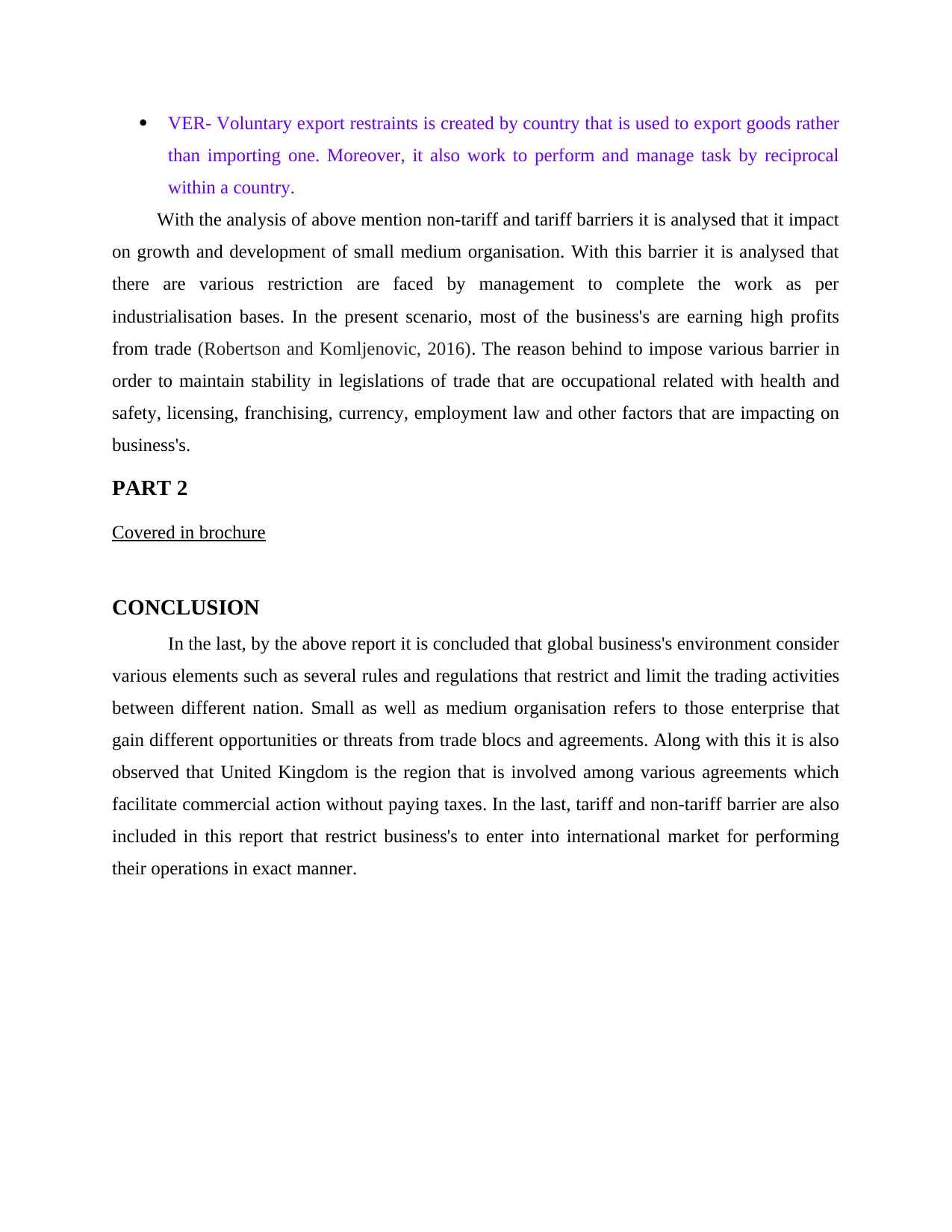
VER- Voluntary export restraints is created by country that is used to export goods rather
than importing one. Moreover, it also work to perform and manage task by reciprocal
within a country.
With the analysis of above mention non-tariff and tariff barriers it is analysed that it impact
on growth and development of small medium organisation. With this barrier it is analysed that
there are various restriction are faced by management to complete the work as per
industrialisation bases. In the present scenario, most of the business's are earning high profits
from trade (Robertson and Komljenovic, 2016). The reason behind to impose various barrier in
order to maintain stability in legislations of trade that are occupational related with health and
safety, licensing, franchising, currency, employment law and other factors that are impacting on
business's.
PART 2
Covered in brochure
CONCLUSION
In the last, by the above report it is concluded that global business's environment consider
various elements such as several rules and regulations that restrict and limit the trading activities
between different nation. Small as well as medium organisation refers to those enterprise that
gain different opportunities or threats from trade blocs and agreements. Along with this it is also
observed that United Kingdom is the region that is involved among various agreements which
facilitate commercial action without paying taxes. In the last, tariff and non-tariff barrier are also
included in this report that restrict business's to enter into international market for performing
their operations in exact manner.
than importing one. Moreover, it also work to perform and manage task by reciprocal
within a country.
With the analysis of above mention non-tariff and tariff barriers it is analysed that it impact
on growth and development of small medium organisation. With this barrier it is analysed that
there are various restriction are faced by management to complete the work as per
industrialisation bases. In the present scenario, most of the business's are earning high profits
from trade (Robertson and Komljenovic, 2016). The reason behind to impose various barrier in
order to maintain stability in legislations of trade that are occupational related with health and
safety, licensing, franchising, currency, employment law and other factors that are impacting on
business's.
PART 2
Covered in brochure
CONCLUSION
In the last, by the above report it is concluded that global business's environment consider
various elements such as several rules and regulations that restrict and limit the trading activities
between different nation. Small as well as medium organisation refers to those enterprise that
gain different opportunities or threats from trade blocs and agreements. Along with this it is also
observed that United Kingdom is the region that is involved among various agreements which
facilitate commercial action without paying taxes. In the last, tariff and non-tariff barrier are also
included in this report that restrict business's to enter into international market for performing
their operations in exact manner.
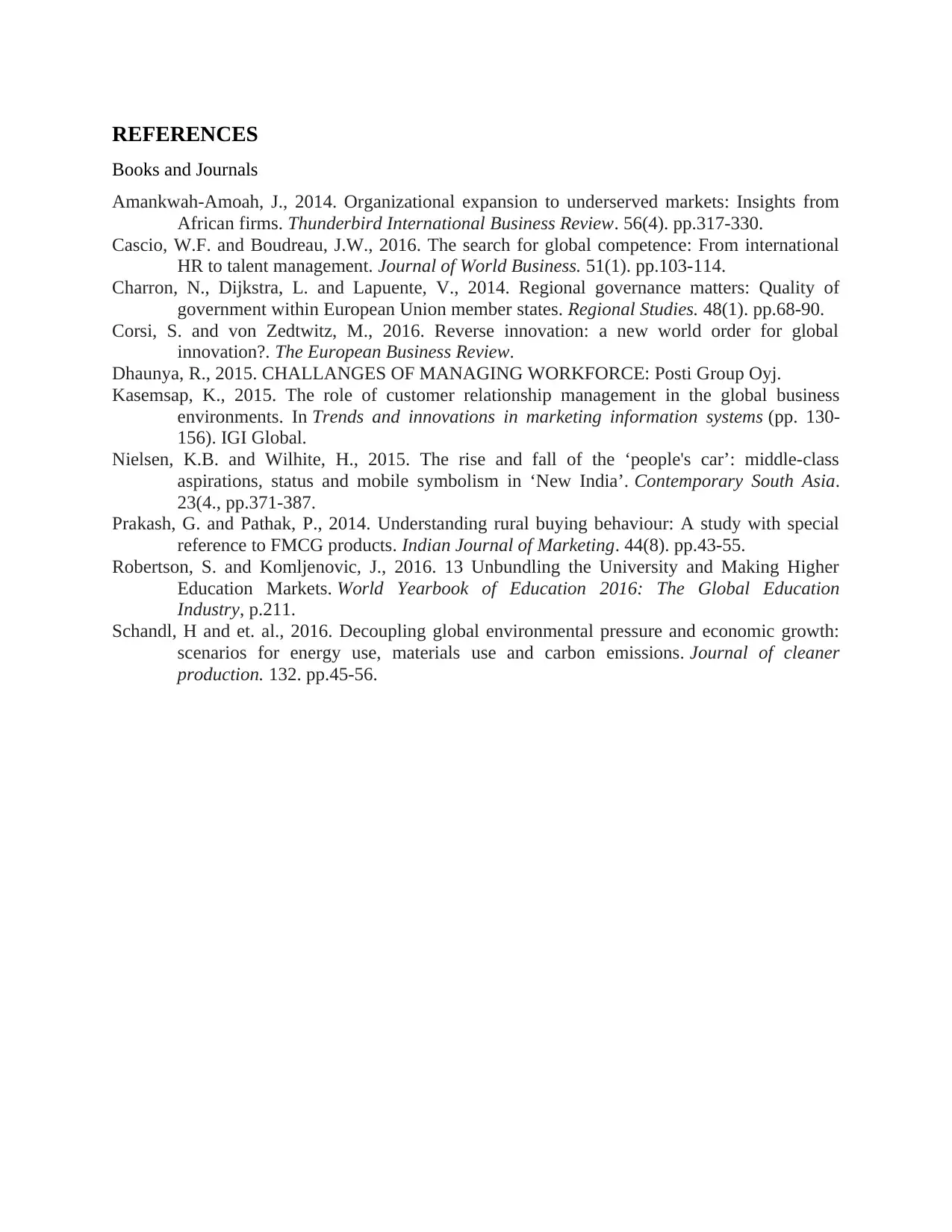
REFERENCES
Books and Journals
Amankwah‐Amoah, J., 2014. Organizational expansion to underserved markets: Insights from
African firms. Thunderbird International Business Review. 56(4). pp.317-330.
Cascio, W.F. and Boudreau, J.W., 2016. The search for global competence: From international
HR to talent management. Journal of World Business. 51(1). pp.103-114.
Charron, N., Dijkstra, L. and Lapuente, V., 2014. Regional governance matters: Quality of
government within European Union member states. Regional Studies. 48(1). pp.68-90.
Corsi, S. and von Zedtwitz, M., 2016. Reverse innovation: a new world order for global
innovation?. The European Business Review.
Dhaunya, R., 2015. CHALLANGES OF MANAGING WORKFORCE: Posti Group Oyj.
Kasemsap, K., 2015. The role of customer relationship management in the global business
environments. In Trends and innovations in marketing information systems (pp. 130-
156). IGI Global.
Nielsen, K.B. and Wilhite, H., 2015. The rise and fall of the ‘people's car’: middle-class
aspirations, status and mobile symbolism in ‘New India’. Contemporary South Asia.
23(4., pp.371-387.
Prakash, G. and Pathak, P., 2014. Understanding rural buying behaviour: A study with special
reference to FMCG products. Indian Journal of Marketing. 44(8). pp.43-55.
Robertson, S. and Komljenovic, J., 2016. 13 Unbundling the University and Making Higher
Education Markets. World Yearbook of Education 2016: The Global Education
Industry, p.211.
Schandl, H and et. al., 2016. Decoupling global environmental pressure and economic growth:
scenarios for energy use, materials use and carbon emissions. Journal of cleaner
production. 132. pp.45-56.
Books and Journals
Amankwah‐Amoah, J., 2014. Organizational expansion to underserved markets: Insights from
African firms. Thunderbird International Business Review. 56(4). pp.317-330.
Cascio, W.F. and Boudreau, J.W., 2016. The search for global competence: From international
HR to talent management. Journal of World Business. 51(1). pp.103-114.
Charron, N., Dijkstra, L. and Lapuente, V., 2014. Regional governance matters: Quality of
government within European Union member states. Regional Studies. 48(1). pp.68-90.
Corsi, S. and von Zedtwitz, M., 2016. Reverse innovation: a new world order for global
innovation?. The European Business Review.
Dhaunya, R., 2015. CHALLANGES OF MANAGING WORKFORCE: Posti Group Oyj.
Kasemsap, K., 2015. The role of customer relationship management in the global business
environments. In Trends and innovations in marketing information systems (pp. 130-
156). IGI Global.
Nielsen, K.B. and Wilhite, H., 2015. The rise and fall of the ‘people's car’: middle-class
aspirations, status and mobile symbolism in ‘New India’. Contemporary South Asia.
23(4., pp.371-387.
Prakash, G. and Pathak, P., 2014. Understanding rural buying behaviour: A study with special
reference to FMCG products. Indian Journal of Marketing. 44(8). pp.43-55.
Robertson, S. and Komljenovic, J., 2016. 13 Unbundling the University and Making Higher
Education Markets. World Yearbook of Education 2016: The Global Education
Industry, p.211.
Schandl, H and et. al., 2016. Decoupling global environmental pressure and economic growth:
scenarios for energy use, materials use and carbon emissions. Journal of cleaner
production. 132. pp.45-56.
⊘ This is a preview!⊘
Do you want full access?
Subscribe today to unlock all pages.

Trusted by 1+ million students worldwide

1 out of 10
Related Documents
Your All-in-One AI-Powered Toolkit for Academic Success.
+13062052269
info@desklib.com
Available 24*7 on WhatsApp / Email
![[object Object]](/_next/static/media/star-bottom.7253800d.svg)
Unlock your academic potential
Copyright © 2020–2025 A2Z Services. All Rights Reserved. Developed and managed by ZUCOL.





